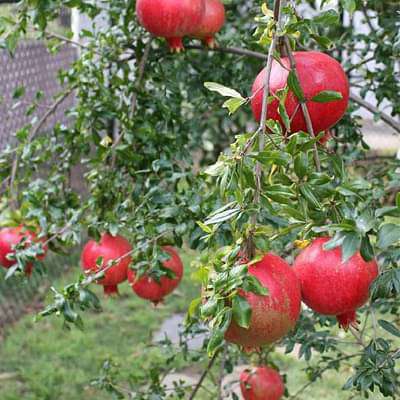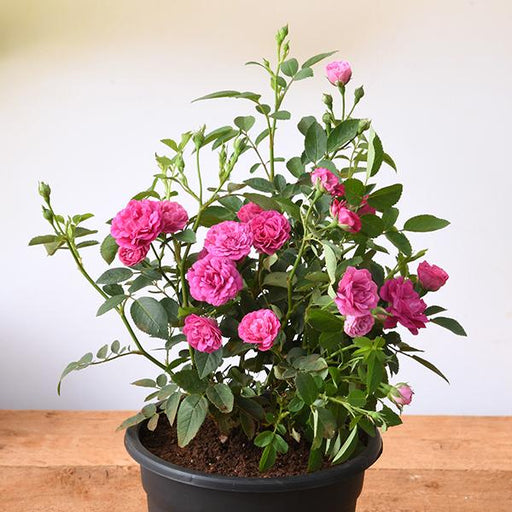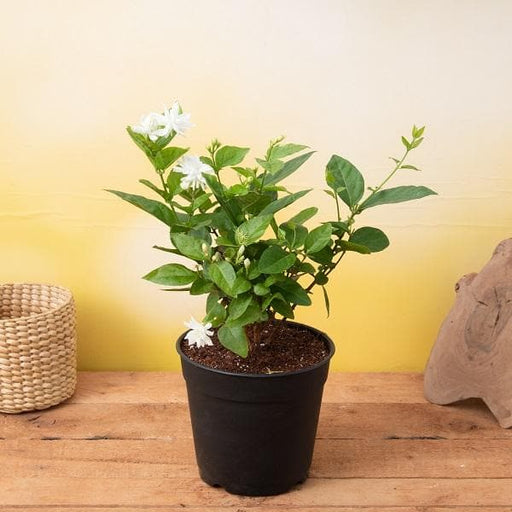
Punica granatum minima - Plant
(MRP Inclusive of all taxes)
- Shipping ₹79 for entire order
- Dispatch in 7 days
- Country of origin: India

(MRP Inclusive of all taxes)
 Save 29%
Save 29%
Air Purifier Money Plant with Pot The Air Purifier Money Plant, also known as Pothos or Epipremnum aureum, is a stunning indoor plant that...
View full details
 Save up to 15%
Save up to 15%
Peace Lily, Spathiphyllum - Plant The Peace Lily, scientifically known as Spathiphyllum, is a stunning houseplant celebrated for its elegant white...
View full details
 Save 25%
Save 25%
Jasminum sambac, Mogra, Arabian Jasmine - Plant Jasminum sambac, commonly known as Mogra or Arabian Jasmine, is a fragrant flowering plant...
View full details
 Save 18%
Save 18%
Combo Constituents Includes the Parijat Tree (Night-Flowering Jasmine), a culturally significant plant with fragrant flowers. Description The Pari...
View full details
 Save 25%
Save 25%
Miniature Rose, Button Rose (Any Color) - Plant The Miniature Rose, also known as the Button Rose, is a charming and compact flowering plant that ...
View full details Save 25%
Save 25%
Damascus Rose, Scented Rose (Any Color) - Plant The Damascus Rose, also known as Rosa damascena, is a timeless symbol of beauty and romanc...
View full details
 Save 17%
Save 17%
Beautiful Fragrant Mogra, Arabian Jasmine Plant with Pot The Beautiful Fragrant Mogra, also known as Arabian Jasmine (Jasminum sambac), is...
View full details Save 15%
Save 15%
Pack of Vermicompost and Neem Cake for House Plants Transform your indoor garden with our premium Pack of Vermicompost and Neem Cake, spec...
View full details
Pack of Plant Growth and Flower Boosters Unlock the full potential of your garden with our Pack of Plant Growth and Flower Boosters! This ...
View full details Save 38%
Save 38%
Combo of Jeevamrut and Neem Raksha for Easy Growth and Protection of Houseplants Transform your indoor garden with our exclusive combo of ...
View full details Save 22%
Save 22%
Plant Nutrients Kit (Pack of 16) for a Healthy Garden Transform your garden into a lush paradise with our Plant Nutrients Kit, featuring 1...
View full details Save 16%
Save 16%
Combo of Top Plant Fertilizers Elevate your gardening game with our exclusive Combo of Top Plant Fertilizers, featuring two bags of premiu...
View full details Save 24%
Save 24%
Pack of 4 Additives to Make Soil Healthy and Nutrient Rich Transform your garden into a thriving ecosystem with our Pack of 4 Additives de...
View full details Save 30%
Save 30%
Transform your gardening experience with our premium Combo of Perlite and Vermiculite. This unique blend is designed to enhance soil aeration and ...
View full details Save 27%
Save 27%
Combo of 2 Vermicompost and Cocopeat - Enrich Your Soil Naturally! Transform your garden into a thriving ecosystem with our Combo of 2 Ver...
View full details
 Save 35%
Save 35%
Best 6 Plants for Perfect Indoor Garden Transform your living space into a lush oasis with our curated collection of the Best 6 Plants for a...
View full details
 Save up to 50%
Save up to 50%
Mini Succulent Garden Pack Transform your space with our Mini Succulent Garden Pack, featuring a delightful collection of 4 any variety beautiful s...
View full details
 Save 30%
Save 30%
5 Best Fragrant Plants Transform your garden or indoor space into a fragrant paradise with our curated selection of the 5 Best Fragrant Plants. Th...
View full details
 Save 24%
Save 24%
Set of 2 Bonsai Looking Grafted Adeniums Transform your indoor or outdoor space with our exquisite Set of 2 Bonsai Looking Grafted Adenium...
View full details Save 45%
Save 45%
Top 4 Die Hard Succulents Pack Transform your indoor or outdoor space with our Top 4 Die Hard Succulents Pack, featuring a curated selecti...
View full details
 Save 30%
Save 30%
5 Best Indoor Plants Pack Transform your living space into a lush oasis with our '5 Best Indoor Plants Pack.' This carefully curated collection fe...
View full details
 Save 25%
Save 25%
Set of 4 Evergreen Air Purifier Plant Pack Transform your indoor space into a lush, green oasis with our Set of 4 Evergreen Air Purifier Pla...
View full details| SrNo | Item Name |
|---|---|
| 1 | Punica granatum minima - Plant |
Punica granatum minima, commonly known as the Dwarf Pomegranate, is a stunning ornamental plant that produces vibrant, miniature pomegranates. This compact shrub typically reaches a height of 2 to 3 feet, making it an ideal choice for small gardens, patios, or indoor spaces. With its glossy green leaves and striking red-orange flowers, this plant not only adds beauty to your landscape but also attracts pollinators, enhancing biodiversity.
What makes the Dwarf Pomegranate special is its ability to thrive in various environments while providing both aesthetic and edible benefits. The fruit, though small, is packed with flavor and nutrients, making it a delightful addition to your culinary repertoire. Historically, pomegranates have symbolized fertility and abundance, making this plant a meaningful choice for any garden.
One of the standout features of Punica granatum minima is its adaptability. It can be grown in pots or directly in the ground, and it tolerates drought conditions once established. This resilience, combined with its ornamental appeal, makes it a favorite among gardeners and landscape designers alike.
Punica granatum minima contributes positively to the environment by attracting pollinators and supporting local ecosystems. Its drought tolerance makes it a sustainable choice for gardens in arid regions, reducing the need for excessive watering and promoting water conservation.
If you think caring for a plant is as easy as watering it and hoping for the best, think again! Punica granatum minima, or the dwarf pomegranate, requires a bit more finesse. This little gem thrives in well-drained soil and loves a sunny spot. Remember, it’s not just a plant; it’s a diva that demands attention. Regular pruning will keep it looking fabulous, and don’t forget to check for pests—because nobody likes an uninvited guest at their garden party!
Who knew that a tiny tree could pack such a punch? The dwarf pomegranate isn’t just a pretty face; it’s a powerhouse of antioxidants and vitamins. Eating its juicy fruits can boost your immune system and keep your skin glowing. Plus, it’s a natural remedy for various ailments. So, while you’re admiring its beauty, you’re also doing your body a favor. Talk about multitasking!
Want to spread the love of your dwarf pomegranate? Propagation is the name of the game! You can easily grow new plants from cuttings or seeds. Just take a healthy cutting, let it callous over, and plant it in some well-draining soil. With a little patience and care, you’ll have a mini orchard in no time. It’s like cloning your favorite plant, but without the sci-fi drama!
Size matters, but not in the way you think! The Punica granatum minima is the perfect choice for those with limited space. This compact tree typically reaches a height of 2 to 3 feet, making it ideal for small gardens or even pots on your balcony. It’s like having a piece of the Mediterranean in your home without the need for a passport. Who knew small could be so mighty?
Get ready for a floral fiesta! The dwarf pomegranate tree is known for its stunning, bright orange-red flowers that bloom in the spring. These beauties not only attract pollinators but also add a splash of color to your garden. It’s like nature’s way of throwing a party, and you’re invited! Just make sure to have your camera ready because these blooms are Instagram-worthy.
Patience is a virtue, especially when waiting for your dwarf pomegranate to bear fruit. After a few years of care, you’ll be rewarded with small, sweet, and tangy pomegranates. These little gems are perfect for snacking or adding to salads. Plus, they’re a conversation starter—who wouldn’t want to brag about their homegrown pomegranates? Just remember, good things come to those who wait!
Sunlight is the secret ingredient to a thriving Punica granatum minima. This little tree loves basking in full sun for at least six hours a day. Think of it as a sunbather on a tropical vacation—without the sunscreen! If you want your dwarf pomegranate to flourish, make sure it’s soaking up those rays. A little sun can go a long way in producing those delicious fruits.
The right soil is like a cozy bed for your dwarf pomegranate. It prefers well-draining soil that’s slightly acidic to neutral. Think of it as a picky eater at a buffet—only the best will do! If your soil is too heavy or compact, your plant might sulk and refuse to grow. So, mix in some sand or perlite to keep it happy and thriving. After all, a happy plant is a productive plant!
Every garden has its villains, and the dwarf pomegranate is no exception. Aphids, spider mites, and scale insects can wreak havoc on your precious plant. But fear not! A little neem oil or insecticidal soap can send these pests packing. Think of it as your plant’s superhero sidekick, swooping in to save the day. Regular checks will keep your dwarf pomegranate safe and sound.
Pruning is like giving your dwarf pomegranate a stylish haircut. It helps maintain its shape and encourages new growth. Aim to prune in late winter or early spring before the growing season kicks off. Just remember to use clean, sharp tools to avoid any plant drama. A little snip here and there can make a world of difference, turning your plant into the belle of the garden ball!
Who says you can’t have a garden indoors? The dwarf pomegranate is a fantastic candidate for indoor growing. Just make sure it gets plenty of sunlight and a pot with good drainage. It’s like having a mini tropical paradise right in your living room. Plus, you’ll impress your guests with your green thumb and exotic fruit tree. Indoor gardening has never looked so chic!
Punica granatum minima, also known as dwarf pomegranate, is a petite powerhouse of a plant. This charming shrub boasts vibrant flowers and tiny, tangy fruits, perfect for those who want a splash of color without the commitment of a full-sized tree. It’s like having a mini fruit party in your garden!
Caring for your Punica granatum minima is a breeze! Provide well-draining soil, plenty of sunlight, and moderate watering. Think of it as a sunbather that occasionally needs a drink. Prune it to maintain its shape, and watch it flourish like a diva at a spa retreat!
Growing Punica granatum minima is like having a personal cheerleader in your garden! It offers ornamental beauty, attracts pollinators, and produces edible fruits. Plus, it’s a conversation starter—who wouldn’t want to brag about their exotic dwarf pomegranate plant at the next garden party
Absolutely! Punica granatum minima is the perfect indoor plant for those with limited space. Just ensure it gets enough sunlight—think of it as a sun-loving diva. With proper care, you’ll have a delightful little fruit factory right in your living room, minus the mess!
Punica granatum minima thrives in warm, sunny climates, ideally USDA zones 8-10. It’s like a sun-seeking vacationer who loves the heat! If you live in a cooler area, consider bringing it indoors during winter. Just remember, it’s not a fan of frost—no one likes a chilly reception!
Water your Punica granatum minima when the top inch of soil feels dry. Think of it as a thirsty friend who needs a drink but doesn’t want to drown! Overwatering can lead to root rot, so keep it hydrated but not soggy. Balance is key, just like in life!
Punica granatum minima typically blooms in late spring to early summer, showcasing its fiery red flowers. It’s like a floral fireworks show! With the right care, you’ll be treated to a stunning display that’ll make your garden the talk of the town. Get your cameras ready!
Punica granatum minima is a compact champion, usually reaching heights of 2 to 3 feet. It’s the perfect size for small gardens or containers—no need for a ladder! This little gem packs a punch with its beauty and fruit production, proving that good things come in small packages.
Yes, Punica granatum minima is generally deer-resistant! Those pesky critters tend to steer clear of its tangy fruits and spiky foliage. It’s like having a bouncer in your garden, keeping unwanted guests at bay. So, plant with confidence and let your dwarf pomegranate shine!
Absolutely! Propagating Punica granatum minima is as easy as pie. You can do it through seeds or cuttings. Just take a healthy cutting, let it root in water or soil, and voilà! You’ll have more dwarf pomegranates to share—or hoard for yourself. No judgment here!
Keep an eye out for aphids, spider mites, and scale insects. These little party crashers can ruin your plant’s vibe. Regularly inspect your plant and use insecticidal soap or neem oil to keep them in check. After all, no one likes uninvited guests at their garden soirée!
Patience is a virtue! Punica granatum minima typically takes about 2 to 3 years to bear fruit after planting. It’s like waiting for a fine wine to mature—worth the wait! Once it starts producing, you’ll enjoy a delightful harvest of tiny, tangy pomegranates that are sure to impress.